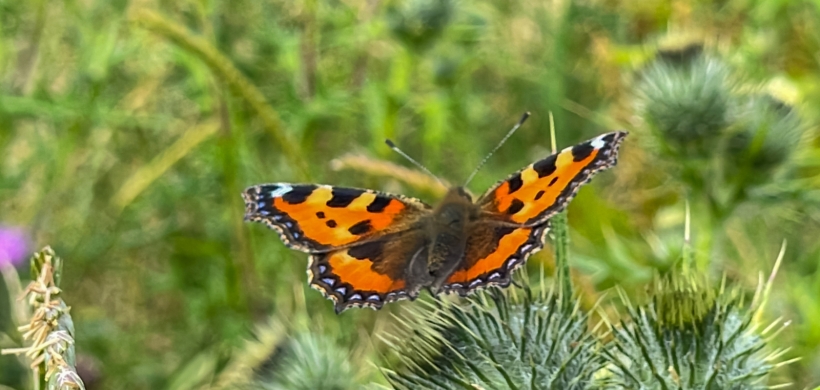What is No Mow May?
No Mow May is an annual campaign organised by Plantlife, a British conservation charity working to protect threatened wild flowers, plants and fungi.
All you have to do to take part in No Mow May is leave all or part of your lawn unmown for the month of May – simple!
At the end of the month, you can record the flowers growing on your lawn and share this information with Plantlife to find out how many bees your lawn is helping.
If you are worried about your garden looking untidy, or if we have been in contact with you about managing your garden, you can leave just an area of your lawn unmown.
Why should I take part in No Mow May?
Pollinators, like bees and butterflies, really need our help.
Pollinators feed on the nectar produced by flowers. As they feed, they pick up pollen, which they then carry to other plants. This allows plants, including the ones we eat, to reproduce. We need to protect pollinators, like bees, so that we can grow the food we need to survive.
Bees, butterflies, and other pollinators are also an important food source for other animals, like birds. By protecting pollinators, you will also be protecting the other animals living in your community.
However, pollinators are in trouble. The UK has lost 97% of our wildflower meadows in the last 70 years, meaning there is less nectar for pollinators to feed on. This, combined with the increased use of pesticides, has caused a worrying decline in pollinator populations.
The good news is you can do something about this.
By changing your mowing routine and allowing the plants in your lawn to flower, your lawn can create enough nectar for ten times more pollinators, meaning that more bees and butterflies will have the food they need to survive.
You will also get to enjoy a variety of flowers popping up in your garden. You do not need to have planted any seeds in your lawn for flowers to appear - just let your lawn grow and see what blooms!
Last year, some people who took part in No Mow May saw bee orchids, snake’s-head fritillaries and eyebrights appear on their lawns.
Every Flower Counts
At the end of the month, you can count the flowers on your lawn to take part in Plantlife’s Every Flower Counts survey. This survey helps Plantlife learn more about the health of the nations’ wild flowers, and in turn helps pollinators like bees and butterflies.
After completing the Every Flower Counts Survey you will get your own personal nectar score, which tells you how many bees your garden is helping to support.
How to look after your lawn and protect wildlife year round
There are plenty of other ways you can use your garden to help wildlife, from building a bug hotel to feeding the birds. Our Gardening Green Advice page is full of tips to make your garden wildlife friendly.
To continue caring for your lawn after No Mow May, you can:
- Stop using weedkiller – weedkiller will kill the flowers growing in your lawn and will poison the soil around it. If you want to remove plants from your garden, you should pull them up by hand.
- Leave areas of your lawn unmown – many plants need to grow taller before they can flower. Leaving a corner of your garden unmown will allow these wild flowers to flourish – and it will look beautiful too!
- Cut the rest of your lawn once every four weeks – Plantlife’s survey previously found that the people with the most flowers in their lawn were the people who mowed their lawn once every four weeks.
What are we doing for No Mow May at LiveWest?
We are also taking part in No Mow May and will be letting the green spaces at our LiveWest offices grow wild to help pollinators.
For more information
For more information about No Mow May, or to find out how to take part in the Every Flower Counts survey, visit the Plantlife website.
For more information about your responsibilities when looking after your garden, visit our Gardening page.

